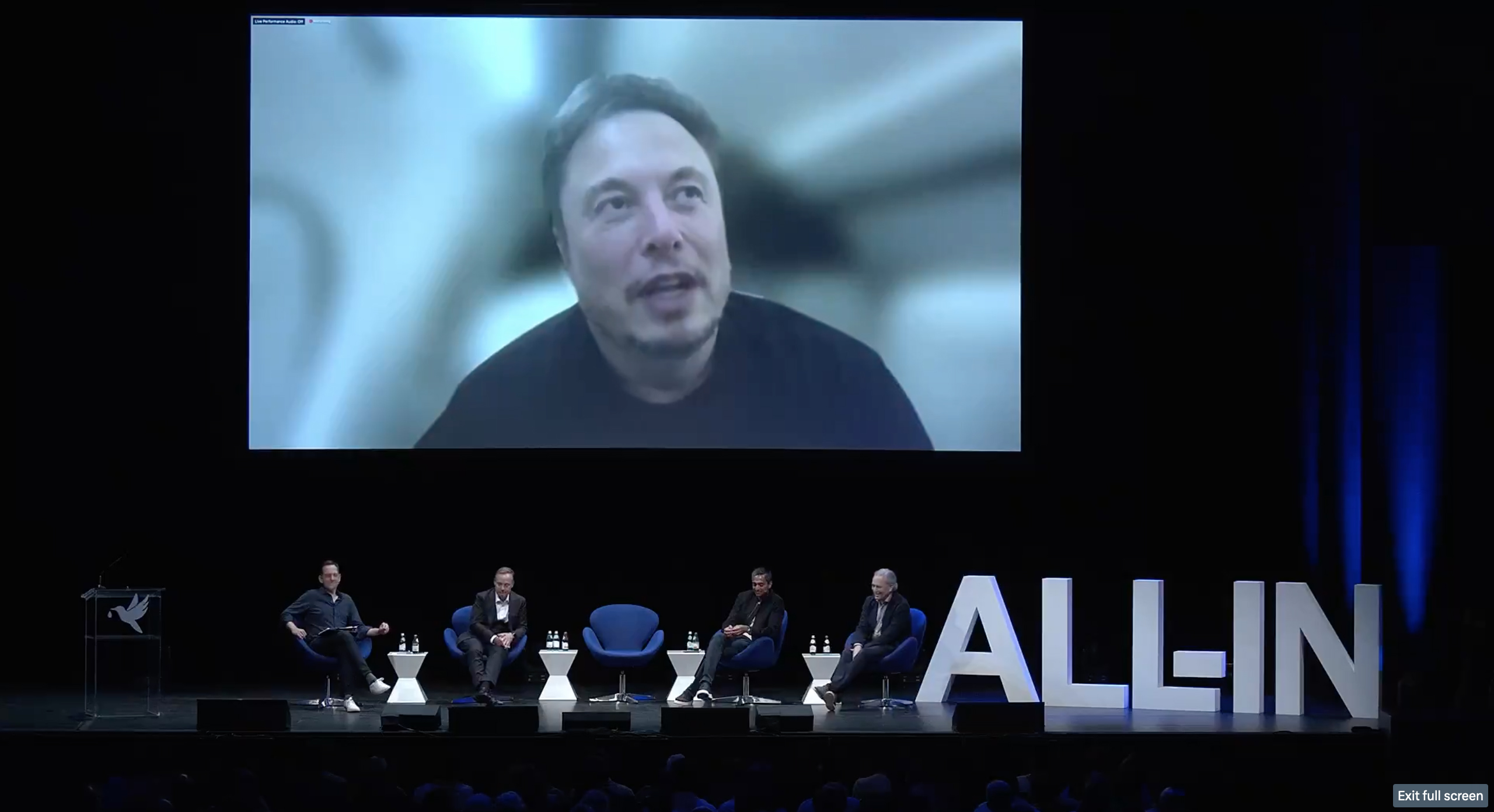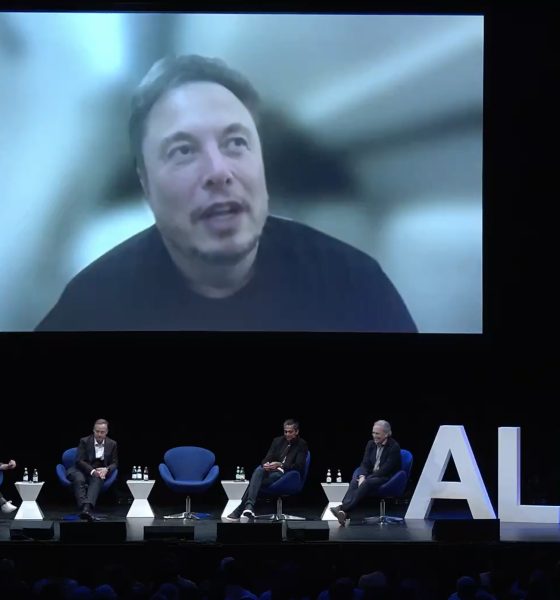During a conference this week, Tesla CEO Elon Musk reiterated claims that the Full Self-Driving (FSD) beta is nearing higher levels of autonomy. The statements echo recent details learned from previews of a new Musk biography, highlighting the FSD system’s many developments in the last several months alone.
Musk was featured in an interview during the All-In Podcast’s 2023 Summit held on Wednesday, during which he discussed topics like Starlink, X, China, artificial intelligence, and more. Among the topics covered was a brief outro on the FSD beta, which he says is “very close” to becoming safer than a human driver without being monitored.
“Yeah, I think it’s getting very close to being in a situation where, even if there’s no human oversight or intervention, that the probability of a safe journey is higher with FSD and no supervision — like even if you’re asleep in the car — than if a person is driving. We’re very close to that,” Musk said on a video call into the summit.
He also pointed to how much the current version of FSD has improved compared to versions from six months ago, a year ago, and 18 months ago. In that time, Musk explained, Tesla has arrived at what it calls the “final piece of the puzzle,” as the company shifts toward making the whole FSD neural network-based.
“And we’ve got the final piece of the puzzle, which is to have the control part of the car transition from about 300,000 lines of C++ code to a [full-scale] neural network, so the whole system will be neural network, photons into controls out,” Musk added.
During the interview, Musk also referred to miles being driven with FSD as being “much safer” than those without it, emphasizing how close the automaker is to solving that “final piece of the puzzle.”
You can watch Musk’s full interview at the 2023 All-In Summit on X, with the FSD discussion taking place around 44:30.
first video from the @allinsummit – in conversation with @elonmusk
available exclusively on @X
(0:00) Besties welcome Elon via Starlink
(05:31) Ukraine and Starlink
(19:10) green shoots of @X
(22:24) the creator economy and optimizing the @x experience
(26:43) the ADL,… pic.twitter.com/vRpnrz3DLV— The All-In Podcast (@theallinpod) September 12, 2023
Tesla Safety Statistics
Tesla releases a regular vehicle safety report detailing quarterly crash results from its Autopilot and FSD systems.
The most recent entry occurred in the fourth quarter of last year, showing fewer crashes when Autopilot technology is engaged than when it isn’t. According to the report, the latest data from the National Highway Traffic Safety Administration (NHTSA) shows that there is an automobile crash in the U.S. every 652,000 miles.
Comparatively, Tesla recorded one crash for every 4.85 million miles driven in Q4 for drivers using its Autopilot systems. Tesla also recorded one crash for every 1.40 million miles driven by drivers in its cars who were not using either of the systems.
The concept of FSD switching to an entirely neural-network-based approach was also detailed earlier this week in previews of a Musk biography written by Walter Isaacson. The biography was published on Wednesday, and it specifically discusses Tesla’s upcoming FSD version 12.
In the past, Musk has said that FSD v12 will no longer be a beta version of the software and will include a significant leap forward.
What are your thoughts? Let me know at zach@teslarati.com, find me on X at @zacharyvisconti, or send your tips to us at tips@teslarati.com.

News
Tesla FSD fleet is nearing 7 billion total miles, including 2.5 billion city miles
As can be seen on Tesla’s official FSD webpage, vehicles equipped with the system have now navigated over 6.99 billion miles.

Tesla’s Full Self-Driving (Supervised) fleet is closing in on almost 7 billion total miles driven, as per data posted by the company on its official FSD webpage.
These figures hint at the massive scale of data fueling Tesla’s rapid FSD improvements, which have been quite notable as of late.
FSD mileage milestones
As can be seen on Tesla’s official FSD webpage, vehicles equipped with the system have now navigated over 6.99 billion miles. Tesla owner and avid FSD tester Whole Mars Catalog also shared a screenshot indicating that from the nearly 7 billion miles traveled by the FSD fleet, more than 2.5 billion miles were driven inside cities.
City miles are particularly valuable for complex urban scenarios like unprotected turns, pedestrian interactions, and traffic lights. This is also the difference-maker for FSD, as only complex solutions, such as Waymo’s self-driving taxis, operate similarly on inner-city streets. And even then, incidents such as the San Francisco blackouts have proven challenging for sensor-rich vehicles like Waymos.
Tesla’s data edge
Tesla has a number of advantages in the autonomous vehicle sector, one of which is the size of its fleet and the number of vehicles training FSD on real-world roads. Tesla’s nearly 7 billion FSD miles then allow the company to roll out updates that make its vehicles behave like they are being driven by experienced drivers, even if they are operating on their own.
So notable are Tesla’s improvements to FSD that NVIDIA Director of Robotics Jim Fan, after experiencing FSD v14, noted that the system is the first AI that passes what he described as a “Physical Turing Test.”
“Despite knowing exactly how robot learning works, I still find it magical watching the steering wheel turn by itself. First it feels surreal, next it becomes routine. Then, like the smartphone, taking it away actively hurts. This is how humanity gets rewired and glued to god-like technologies,” Fan wrote in a post on X.
News
Tesla starts showing how FSD will change lives in Europe
Local officials tested the system on narrow country roads and were impressed by FSD’s smooth, human-like driving, with some calling the service a game-changer for everyday life in areas that are far from urban centers.

Tesla has launched Europe’s first public shuttle service using Full Self-Driving (Supervised) in the rural Eifelkreis Bitburg-Prüm region of Germany, demonstrating how the technology can restore independence and mobility for people who struggle with limited transport options.
Local officials tested the system on narrow country roads and were impressed by FSD’s smooth, human-like driving, with some calling the service a game-changer for everyday life in areas that are far from urban centers.
Officials see real impact on rural residents
Arzfeld Mayor Johannes Kuhl and District Administrator Andreas Kruppert personally tested the Tesla shuttle service. This allowed them to see just how well FSD navigated winding lanes and rural roads confidently. Kruppert said, “Autonomous driving sounds like science fiction to many, but we simply see here that it works totally well in rural regions too.” Kuhl, for his part, also noted that FSD “feels like a very experienced driver.”
The pilot complements the area’s “Citizen Bus” program, which provides on-demand rides for elderly residents who can no longer drive themselves. Tesla Europe shared a video of a demonstration of the service, highlighting how FSD gives people their freedom back, even in places where public transport is not as prevalent.
What the Ministry for Economic Affairs and Transport says
Rhineland-Palatinate’s Minister Daniela Schmitt supported the project, praising the collaboration that made this “first of its kind in Europe” possible. As per the ministry, the rural rollout for the service shows FSD’s potential beyond major cities, and it delivers tangible benefits like grocery runs, doctor visits, and social connections for isolated residents.
“Reliable and flexible mobility is especially vital in rural areas. With the launch of a shuttle service using self-driving vehicles (FSD supervised) by Tesla in the Eifelkreis Bitburg-Prüm, an innovative pilot project is now getting underway that complements local community bus services. It is the first project of its kind in Europe.
“The result is a real gain for rural mobility: greater accessibility, more flexibility and tangible benefits for everyday life. A strong signal for innovation, cooperation and future-oriented mobility beyond urban centers,” the ministry wrote in a LinkedIn post.
News
Tesla China quietly posts Robotaxi-related job listing
Tesla China is currently seeking a Low Voltage Electrical Engineer to work on circuit board design for the company’s autonomous vehicles.

Tesla has posted a new job listing in Shanghai explicitly tied to its Robotaxi program, fueling speculation that the company is preparing to launch its dedicated autonomous ride-hailing service in China.
As noted in the listing, Tesla China is currently seeking a Low Voltage Electrical Engineer to work on circuit board design for the company’s autonomous vehicles.
Robotaxi-specific role
The listing, which was shared on social media platform X by industry watcher @tslaming, suggested that Tesla China is looking to fill the role urgently. The job listing itself specifically mentions that the person hired for the role will be working on the Low Voltage Hardware team, which would design the circuit boards that would serve as the nervous system of the Robotaxi.
Key tasks for the role, as indicated in the job listing, include collaboration with PCB layout, firmware, mechanical, program management, and validation teams, among other responsibilities. The role is based in Shanghai.
China Robotaxi launch
China represents a massive potential market for robotaxis, with its dense urban centers and supportive policies in select cities. Tesla has limited permission to roll out FSD in the country, though despite this, its vehicles have been hailed as among the best in the market when it comes to autonomous features. So far, at least, it appears that China supports Tesla’s FSD and Robotaxi rollout.
This was hinted at in November, when Tesla brought the Cybercab to the 8th China International Import Expo (CIIE) in Shanghai, marking the first time that the autonomous two-seater was brought to the Asia-Pacific region. The vehicle, despite not having a release date in China, received a significant amount of interest among the event’s attendees.










